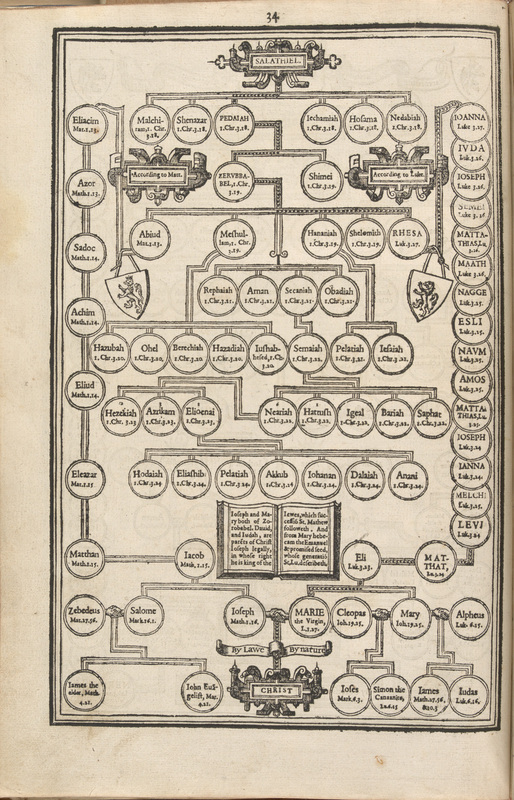Matthew’s genealogy is a carefully constructed composition.
And it’s as close to a proof-text for gematria as I’m likely to find in Scripture, so I’d be a fool not to take advantage of it.
In any case, the study of genealogies has the potential to lead to tenure.
Leslie McFall wrote 500,000 words on Matt. 1.11 alone.
To kick off, then, a few words on the numerical properties of Matthew’s genealogy:
🔹 It’s built around the number 14.
🔹 It divides into three lists of 14 (cp. 1.17).
🔹 And the name ‘David’ is mentioned three times in the course of Matthew’s genealogy (per its three 14-generation lists) and 14 times elsewhere in Matthew.
🔹 Matthew’s list consists of a total of 42 names (counted per 1.17), which makes Jesus the 42nd generation from Abraham.
🔹 The most frequent word in Matthew’s genealogy is τον, which occurs 42 times and has a gematrial value of 420.
since the words ואלה תולדת = ‘Now these are the generations’ (cp. Gen. 11.27, 25.19, etc.) resonate with the number 42 (insofar as 42 = ואלה and 420 = תולדת/תלדות).
Matthew wants to portray Jesus not as an otherworldly deliverer who materialises out of thin air,
but as the summary and fulfilment of Israel’s history—the culmination of Abraham’s ‘generations’ (תולדת),
and the one who will usher in a new phase in Israel’s history.
Insofar as Matthew’s genealogy moves forward in groups of 14, it resembles the course of the moon,
which waxes for 14 days and wanes for 14 days.
We then *expect* David to usher in a line of godly and successful kings in 1.6b–11,
but none is forthcoming.
as a line of 14 largely godless kings lead Israel down in exile,
Suffice it to say, Jesus must tread a similar road.
into an exile of death.
But, just as Jehoiachin is ‘lifted up’ from prison (2 Kgs. 25), so Jesus will be raised up and delivered from ‘the bars of the grave’ (Jon. 2).
Note: For further details on Shealtiel’s role within Matthew, cf. academia.edu/41135348/.
Matthew claims to have uncovered a fundamental pattern/periodicity in Israel’s history.
Israel’s story unfolds in blocks of 14, each of which reaches a significant zenith/nadir in its 14th generation.
so she traverses the long era between Abraham and the fulfilment of his promise by means of 42 generations.
——————
But how authentic is the pattern portrayed in Matthew’s genealogy?
Is it grounded in historical/textual reality? Or is it a pattern of Matthew’s own creation?
Matthew traverses 1,000 years with his first 14 generations, 400 with his next 14, and 60 with his final 14.
Matthew’s genealogies must, therefore, be selective.
But who’s made the relevant selections? And on what basis?
but it’s at least *possible* Jesus was listed as the 14th generation from the exile in certain genealogies.
And 10 generations is too few to take us from c. 450 BC to 70 AD.
And might a similarly selective genealogy (from Ezra’s day onwards) have been available to Matthew, which he included (unedited) in his genealogy?
If the interval from 450 BC to 70 AD could (conventionally) be spanned by a 10-generation genealogy,
then it would seem about right to span the interval from c. 600 BC to Jesus’ birth with a 14-generation genealogy,
——————
So, what about the other two legs of Matthew’s genealogy?
It comes straight from the text of 1 Chr. 2.1–15 (alt. Ruth 4.18–22),
That then leaves us with Matthew’s record of Judah’s kings.
Or, to put the question more specifically, why has Matthew omitted Ahaziah, Jehoash, and Amaziah (cp. 1 Chr. 3)?
With the rise of Ahab, a remarkable sequence of events begins to unfold in Israel’s history.
Assisted by Jezebel, Ahab ruthlessly enforces the worship of Baal in Israel (at the cost of YHWH’s prophets).
which has become inseparably intertwined with *Judah’s* household (due to the marriage of Ahab’s daughter and Jehoshaphat’s son).
God’s chosen instrument of judgment is Jehu.
Note: Like certain other people I know, Jehu is recognisable by ‘the fury of his driving’ (2 Kgs. 9.20).
apparently in answer to YHWH’s promise to visit the iniquity of the fathers on their children up until the fourth generation (Exod. 34.7).
at which point YHWH restates his authorisation of Jehu’s reign for four generations (cp. 2 Kgs. 10.30, 15.12).
YHWH’s choice of words in his commission of and comment on Jehu’s reign is noteworthy.
Israel’s northern and southern kingdoms are briefly reuinted (due to the intermarriage between Ahab and Jehoram) and jointly given over to Jehu in order to be punished.
In sum, then, the fourteen-fold pattern reflected in Matthew’s genealogy is theological and apologetically significant,
and, given what we’ve noted above, we have reason to think it is not merely Matthew’s creation.
but has *identified* a pattern which is present in Israel’s historical records, and which points towards Jesus as the fulfilment of Abraham’s promise.
THE END.
#ItCouldBeYou














